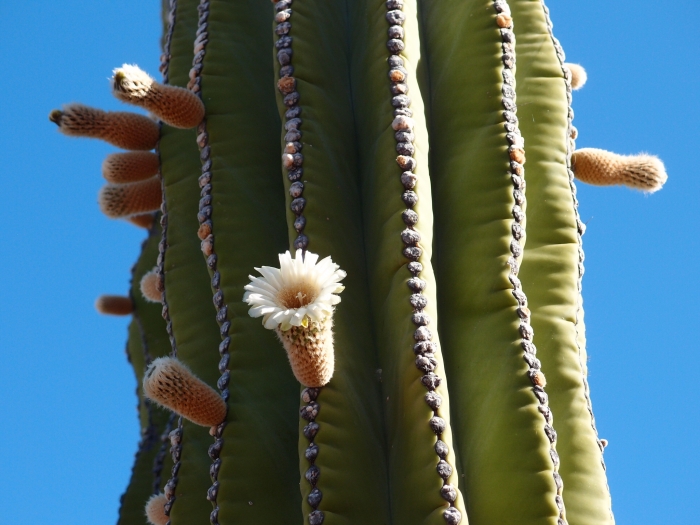Mexican Giant Cardon
(Pachycereus pringlei)
Mexican Giant Cardon (Pachycereus pringlei)
/
/

Sue Carnahan
CC BY 4.0
Image By:
Sue Carnahan
Recorded By:
Copyright:
CC BY 4.0
Copyright Notice:
Photo by: Sue Carnahan | License Type: CC BY 4.0 | License URL: http://creativecommons.org/licenses/by/4.0/ | Rights Holder: Sue Carnahan | Publisher: iNaturalist | Date Created: 2014-04-28T08:10:59-07:00 |

























Estimated Native Range
Summary
Pachycereus pringlei, commonly known as Mexican Giant Cardon or Elephant Cactus, is a slow-growing, large cactus native to the arid and semi-arid regions of northwestern Mexico, specifically in the states of Baja California, Baja California Sur, and Sonora. It is often found in desert scrub and rocky hillsides where it forms a dominant feature of the landscape. This species can reach up to 63 feet in height with a stout trunk up to 3 feet in diameter, and it bears several erect branches. The Mexican Giant Cardon is notable for its white, large, nocturnal flowers that bloom in the late spring to early summer and are pollinated by bats. The fruits that follow are considered important to the Seri people, who inhabit the Sonoran desert. The cactus has a lifespan measured in hundreds of years and is similar in appearance to the saguaro cactus but is more heavily branched and has different areoles and spination.
In cultivation, the Mexican Giant Cardon is valued for its dramatic presence and sculptural form, making it a striking focal point in xeriscapes, desert gardens, and large open spaces. It requires minimal maintenance and thrives in full sun with well-draining soil. Due to its ability to fix nitrogen through a symbiotic relationship with bacterial and fungal colonies on its roots, it can grow on bare rock and adapt to poor soil conditions. However, it is sensitive to cold and must be protected from frost. While it is slow-growing, its growth can be enhanced in initial stages by inoculation with plant growth-promoting bacteria. Gardeners should be aware that this cactus can take many years to reach significant size and that it requires ample space to accommodate its eventual large size.CC BY-SA 4.0
In cultivation, the Mexican Giant Cardon is valued for its dramatic presence and sculptural form, making it a striking focal point in xeriscapes, desert gardens, and large open spaces. It requires minimal maintenance and thrives in full sun with well-draining soil. Due to its ability to fix nitrogen through a symbiotic relationship with bacterial and fungal colonies on its roots, it can grow on bare rock and adapt to poor soil conditions. However, it is sensitive to cold and must be protected from frost. While it is slow-growing, its growth can be enhanced in initial stages by inoculation with plant growth-promoting bacteria. Gardeners should be aware that this cactus can take many years to reach significant size and that it requires ample space to accommodate its eventual large size.CC BY-SA 4.0
Plant Description
- Plant Type: Succulent
- Height: 10-40 feet
- Width: 8-15 feet
- Growth Rate: Slow
- Flower Color: White
- Flowering Season: Spring, Summer
- Leaf Retention: Evergreen
Growth Requirements
- Sun: Full Sun
- Water: Very Low
- Drainage: Fast, Medium
Common Uses
Drought Tolerant, Fire Resistant, Low Maintenance, Rock Garden, Showy Flowers, Street Planting
Natural Habitat
Native to arid and semi-arid regions of northwestern Mexico, specifically desert scrub and rocky hillsides
Other Names
Common Names: Elephant Cactus, Mexican Giant Cardon, Cardon Gigante, Cardon Pelon, Sagueso, Sahuaso, Cardón
Scientific Names: , Pachycereus pringlei, Cereus calvus, Cereus calvus, Cereus pringlei, Cereus pringlei var. calvus, Cereus titan, Cereus titan, Pachycereus calvus, Pachycereus pringlei f. calvus
GBIF Accepted Name: